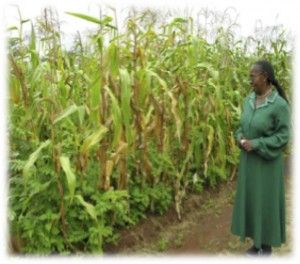Legume Best Bets
Description

Tephrosia vogelli for soil fertility and fuelwood
Legume Best Bests are leguminous crops identified for their ability to improve soil quality and agricultural productivity while adequately addressing farmers’ diverse requirements for adoption. Legumes are capable of providing plant-available nitrogen, a highly limiting nutrient in many agroecosystems, improving nutrient cycling and water use efficiency, and offering multiple secondary benefits. However, their performance can be highly variable limiting their usefulness and adoption by farmers. Legume Best Bets are typically represented by a set of options that optimize physical performance while meeting multiple needs of farmers (see multipurpose legumes and doubled up legumes for more information). Continue here to learn more about legume best bets…
Smallholder farmers in sub-Saharan Africa are often challenged by low soil fertility and limited landholdings, resulting in poor agricultural productivity. In Malawi, inorganic fertilizers are often unaffordable and livestock holdings that could provide organic fertilizer sources are limited. Thus, researchers have focused on integrating high-quality legumes, which can biologically fix atmospheric nitrogen in a plant-available form, into the maize (Zea mays) based cropping system (Snapp et al. 1998). Integrating legumes into the landscape can also improve nutrient use efficiency (Snapp et al. 2010), prevent soil erosion, improve microclimate, enhance water availability, and provide secondary benefits to farmers (Snapp et al. 2002a). Secondary benefits include nutritious food sources, fuelwood, weed suppression, and marketable cash crops.
Yet, legume adoption and leafy biomass incorporation is low across sub-Saharan Africa (Snapp et al. 2002b), in part for the following reasons. Benefits offered by legumes can vary widely between and within species and across agroecological conditions such as landscape, soil type, and climate (Giller et al. 1997). Additionally, legumes often perform differently under on-farm conditions than their potential as indicated from research studies (Mhango et al. 2012). Finally, researchers have often assumed that farmers’ priorities are to maximize yields. More recent efforts to understand farmers’ requirements indicate a greater emphasis on maximizing food security or high returns on small investments (Snapp et al. 2002a).
Best Bet Legumes in Southern Africa grew out of researcher-farmer partnerships, such as ICRISAT’s mother-baby trials, to identify cultivars that perform well under on-farm conditions while meeting farmers’ diverse requirements (Snapp et al. 2002b, Twomlow et al. 2002). Farmer feedback helped to identify socioeconomic constraints and benefits that promoted or inhibited farmer adoption (Twomlow et al. 2002). Examples of Legume Best Bets include: common bean (Phaseolus vulgaris L.), Gliricidia sepium, groundnut (Arachis hypogaea), velvet bean (Macuna puriens), pigeonpea (Cajanus cajan), Sesbania sesban, soya bean (Glycine max), and fish bean (Tephrosia vogelii). Approaches to incorporating the legumes into agroecosystems are also diverse and significant for outcomes. The legumes can be sole cropped, double cropped, intercropped, used within rotations, or even perennialized in the system with leafy portions applied through biomass transfer. Finally, legumes are not a stand-alone option, and productivity is often enhanced when they are combined with small amounts of inorganic fertilizer (e.g. Snapp et al. 2002a).
Principles:
- Improve agricultural productivity
- Provide Biological Nitrogen Fixation (BNF),
- Decrease inorganic fertilizer requirements due to BNF,
- Improve soil quality,
- Alleviate soil erosion through root presence,
- Improve water cycling,
- Provide weed suppression,
- Offer complementary relationships between legume and maize (Zea mays),
- Increase agrobiodiversity,
- Provide alternate valuable resources to farmers including nutrition, fuelwood, cash crops, pesticide sources, etc., depending on the legume variety,
- Offer climate change resilience through crop diversification and improved local water use efficiency.
Debates:

Pigeonpea for soil quality and food
- Possibly a marginal loss of maize yield and resource competition between crops,
- Requires resources such as seed, labor, and land,
- May require skilled management
- Often a lack of short-term return on investment,
- Output markets may be variable and risky,
- Often tradeoffs between legumes grown for grain versus organic matter additions.
Learning Lab Research:
Beedy, T.L., S.S. Snapp, F.K. Akinnifesi, and G.W. Sileshi. 2010. Impact of Gliricidia sepium intercropping on soil organic matter fractions in a maize-based cropping system. Agriculture, Ecosystems & Environment 138(3-4): 139-146.
Bezner-Kerr, R., S.S. Snapp, M. Chirwa, L. Shumba and R. Msachi. 2007. Participatory research on legume diversification with Malawian smallholder farms for improved human nutrition and soil fertility. Experimental Agriculture 43: 437-453.
Kumwenda, J.D.T., S.R. Waddington, S.S. Snapp, R.B. Jones, and M.J. Blackie. 1996. Soil Fertility Management Research for Maize Cropping Systems of Smallholders in Southern Africa: A Review. NRG Paper 96-02. Mexico, D.F.: CIMMYT.
Mhango, W.G., Snapp, S.S., and G.Y.K. Phiri. 2012. Opportunities and constraints to legume diversification for sustainable maize production on smallholder farms in Malawi. Renewable Agriculture and Food Systems 28: 234-244.
Snapp, S.S., M.J. Blackie, R.A. Gilbert, R. Bezner-Kerr and G.Y. Kanyama-Phiri. 2010. Biodiversity can support a greener revolution in Africa. PNAS 107(48): 20840-20845.
Snapp, S.S., R.B. Jones, E.M. Minja, J. Rusike and S.N. Silim. 2003. Pigeon pea for Africa: A versatile vegetable – and more. HortScience 38:1073-1078.
Snapp, S., G.Y. Kanyama-Phiri, B. Kamanga, R. Gilbert, and K. Wellard. 2002a. Farmer and researcher partnerships in Malawi: Developing soil fertility technologies for the near-term and far-term. Experimental Agriculture 10; 411-431.
Snapp, S.S., D.D. Rohrbach, F. Simtowe, and H.A. Freeman. 2002b. Sustainable soil management options for Malawi: Can smallholder farmers grow more legumes? Agriculture, Ecosystems and Environment 91: 159-174.
Snapp, S., V. Aggarwal, and R. Chirwa. 1998. Note on phosphorus and cultivar enhancement of biological enhancement of biological nitrogen fixation and productivity of maize/bean intercrops in Malawi. Field Crops Research 58: 205-212.
Snapp, S., P.L. Mafongoya, and S. Waddington. 1998. Organic Matter Technologies for Integrated Nutrient Management in Smallholder Cropping Systems of Southern Africa. Agriculture, Ecosystems & Environment 71:185-200.
Twomlow, S.J.m, D.K. Friesen, A.F.E. Palmer, J. Ruskie, and S.S. Snapp. 2002. Biophysical or economic performance – which reflects farmer choice of legume ‘best best’ in Malawi? CIMMYT: Proceedings of the Eastern and Southern Africa Regional Maize Conference, 5-11 Feb, 2002.
Links

Annuals for food and soil quality- soybean and groundnuts
Legume Best Bets in Northern Malawi: Article 1, Article 2, Article 3.
ICRISAT’s research on grain legumes
Legume Research Network Project Newsletters on Legume Best Bets in Kenya
Extended Bibliography and Works Cited:
Dakora, F.D. and S.O. Keya. 1997. Contribution of legume nitrogen fixation to sustainable agriculture in sub-Saharan Africa. Soil Biology and Biochemistry 29: 809-817.
Gilbert RA. 2004. Best-bet legumes for smallholder maize-based cropping systems of Malawi. In: Eilitta M, Mureithi J, Derpsch R, (eds). Green Manure/Cover Crop Systems of Smallholder Farmers: Experiences from Tropical and Sub-Tropical Regions. Dordrecht, The Netherlands: Kluwer; pp. 153–174.
Mureithi, J.G., C.K.K. Gachene, and J. Ojiem. 2003. The role of green manures in smallholder farming systems in Kenya: the Legume Research Network Project. Tropical and Subtropical Agroecosystems 1: 57-70.
Nandwa, S.M., S.N. Obanyi, and P.L. Mafongoya. 2011. Agro-ecological Distribution of Legumes in Farming Systems and Identification of Biological Niches for Legumes Growth. In: (eds) Bationo, A., Waswa, B., Okeyo, J.M., Maina, F., Kihara, J., Mokwunye, U. Fighting Poverty in sub-Saharan Africa: The Multiple Roles of Legumes in Integrated Soil Fertility Management. Dordrecht, The Netherlands: Springer; pp 1-26.
Place, F., C.B. Barrett, H.A. Freeman, J.J. Ramisch, and B. Vanlauwe. 2003. Prospects for integrated soil fertility management using organic and inorganic inputs: evidence from smallholder African agricultural systems. Food Policy 28:365-378.
Wani, S.P., O.P. Rupela, and K.K. Lee. 1995. Sustainable agriculture in the semi-arid tropics through biological nitrogen fixation in grain legumes. Plant and Soil 174: 29-49.
Wegary, D., A. Temesgen, S. Admasu, S. Jemal, A. Tirfessa, L. Hidato, F. Getnet, G. Bogale, T. Chibsa, and M. Mekuria. 2011. Towards sustainable intensification of maize-legume cropping systems in Ethiopia. Pp 115-122. Meeting the Challenges of Global Climate Change and Food Security Through Innovative Maize Research. Proceedings of the 3rd National Maize Workshop of Ethiopia. April 18-20, 2011. Addis Ababa, Ethiopia.
Woomer, P.L. 2007. Costs and returns to soil fertility management options in Western Kenya. In: Bationa, A. (ed) Advances in Integrated Soil Fertility Management in sub-Saharan Africa: Challenges and Opportunities. Dordrecht, The Netherlands: Springer; pp 877-885.
Challenges Addressed: Poverty and Food Insecurity, Soil Quality and Low Productivity, Poor Access to Inorganic and Organic Inputs, Climate Change.
Tags: Agricultural Economics, Agrobiodiversity, Agronomy, Extension, Nutrition, Sociology, Soil Science.



